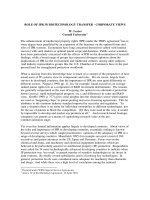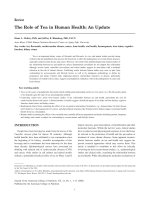Possible role of diva in microglial dual effects and the stem cell differentiation
Bạn đang xem bản rút gọn của tài liệu. Xem và tải ngay bản đầy đủ của tài liệu tại đây (3.17 MB, 185 trang )
POSSIBLE ROLE OF DIVA IN MICROGLIAL DUAL EFFECTS
AND THE STEM CELL DIFFERENTIATION
LI LV
(B.Sc)
A THESIS SUBMITTED FOR THE DEGREE OF
DOCTOR OF PHILOSOPHY
DEPARTMENT OF ANATOMY
YONG LOO LIN SCHOOL OF MEDICINE
NATIONAL UNIVERSITY OF SINGAPORE
2007
ii
ACKNOWLEDGMENTS
I would like to express my deepest appreciation to my three supervisors, Assistant
Professor He Beiping, Associate Professor Lu Jia and Associate Professor Samuel
Sam Wah Tay, Department of Anatomy, National University of Singapore, for their
innovative ideas, invaluable guidance, constant encouragement, infinite patience, and
friendly critics throughout this study. Without them, this dissertation would never be
completed.
I am very grateful to Professor Ling Eng Ang, Head of Anatomy Department, National
University of Singapore, for his constant support and encouragement to me, and also for
his full support in using the excellent research facilities.
I must also acknowledge my gratitude to Mrs Yong Eng Siang, Mrs Ng Geok Lan, Mrs
Cao Qiong, Ms Chan Yee Gek and the late Miss Margaret Sim for their excellent
technical assistance; Mr Yick Tuck Yong, Mr Low Chun Peng and Ms Bay Song Lin
for their constant assistance in computer work; Mr Lim Beng Hock for looking after the
experimental animals; and Mdm Ang Lye Gek Carolyne, Mdm Diljit Kaur, Mdm Teo
Li Ching Violet for their secretarial assistance.
I would like to express my special thanks to Associate Professor Shabbir M.
Moochhala, Ms Tan Mui Hong, Ms Tan Li Li and Ms Clara Lim, DEMRI, DSO
National Laboratories, their continuous help, support and advice when I did my project in
DSO National Laboratories.
iii
I would like to thank all other staff members and my fellow postgraduate students at
Department of Anatomy, National University of Singapore for their help and support.
I would like to take this opportunity to express my heartfelt thanks to my parents for their
full and endless support for my study.
iv
This thesis is dedicated to
my beloved family
v
PUBLICATIONS
International Journals:
1: Li L, Lu J, Tay SS, Moochhala SM, He BP. The function of microglia, either
neuroprotection or neurotoxicity, is determined by the equilibrium among factors
released from activated microglia in vitro. Brain Res. 2007 Jul 23;1159:8-17
2: Li L, Lu J, Tay SS, Moochhala SM, He BP. Diva plays a protective role in NSC-34
cells under microglia cytotoxicity and promote the proliferation of NSC-34 cells in vitro.
(In preparation)
3: Li L, Lu J, Tay SS, Moochhala SM, He BP. The possible role of Diva during neural
stem cells differentiation. (In preparation)
Conference papers:
1: Li L, Tay SSW, Lu J, Moochhala S, He BP. The Effects of LPS-activated BV-2
Conditioned Medium on The NSC-34 Cells, Protective or Toxic? The 16th International
Microscopy Congress 2006. 3rd-8th September, 2006. Sapporo, Japan.
2: Li L, Tay SSW, Lu J, Moochhala S, He BP. LPS-activated BV- conditioned media
cause the translocation of Diva from cytosol to mitochondria. 6th National Symposium
on Health Sciences 2006. 6th-7th June, 2006, Kuala Lumpur, Malaysia.
3: Li Lv, Tay SSW, Lu J, Moochhala S, He BP. Protective effects of LPS-activated
BV-2 conditioned medium on the formation of aggregates in NSC-34 cells. China-
Singapore Biomedical Science Conference. 3rd-7th, December, 2004, Kunming, Yunnan,
China.
4: Li Lv, Tay SSW, Lu J, Moochhala S, He BP. Aggregate-bearing motor neurons are
more vulnerable to microglial toxicity. 8th NUS-NUH Annual Science Meeting, 2nd-3rd
October, 2004, Singapore
vi
TABLE OF CONTENTS
ACKNOWLEDGEMENTS…………………………………………………………… ii
DEDICATIONS…………………………………………………………………………iv
PUBLICATIONS……………………………………………………………………… v
TABLE OF CONTENTS……………………………………………………………….vi
ABBREVIATIONS…………………………………………………………………….xiv
SUMMARY……………………………………………………………………………xvii
CHAPTER 1 INTRODUCTION……………………………………………………… 1
1. Microglia in the central nervous system……………………………………………… 2
2. Molecular aspects of microglia…………………………………………………………2
3. Microglia in neurodegenerative diseases……………………………………………….4
4. Dual functions of microglia…………………… …………………………………… 5
4.1. Microglial neuroprotective function…………………………………………… 7
4.2. Microglial cytotoxicity………………………………………………………… 8
4.3. Microglial dual-function: when and why……………………………………… 9
5. Apoptosis and neuron death………………………………………………….……… 10
5.1. Apoptosis……………………………………………………………….……….10
5.2. Necrosis……………………………………………………………………… 10
5.3. Involvement of apoptosis in neurological diseases…………………………… 11
5.4. Microglial cytotoxicity induced apoptosis…………………………………… 11
5.5. Caspases and two apoptosis pathways.……………………………… ………12
5.5.1. Death-receptor activated apoptosis……………………………………….12
vii
5.5.2. Mitochondria-mediated apoptosis……………………………….……… 13
5.6. Key regulators of mitochondrial apoptosis………………………….………….14
5.6.1. Bcl-2 family …………………………………………………………… 14
5.6.2. Bcl-2 family members in neuron death………………………………… 15
5.6.3. Diva, a new identified Bcl-2 family member…………………………… 16
5.6.3.1. Structure of Diva……………………………………………… 17
5.6.3.2. Distribution of Diva in vivo…………………………………….17
5.6.3.3. Function of Diva in apoptosis………………………………… 18
5.6.4. Bcl-2 family members in cell cycle……………………………………….19
6. Cell cycle and stem cell differentiation……………………………………………….20
6.1. Neural stem cells……………………………………………………………… 20
6.1.1. Neural stem cells in vivo and in vitro………………………………… …21
6.1.2. Bcl-2 family members and neural stem cells…………………………… 22
7. Hypothesis……………………………………………………………………………22
8. Aims and scopes…………………………………………………………………… 24
8.1. To identify the possible relationship between microglia activation and its dual
function in vitro……………………………………………………………….24
8.2. To verify microglial protective or destructive function in protein aggregate-
containing neuron model in vitro…………………………………………… 24
8.3. To identify the possible involvement of Bcl-2 family members in neurons during
the interaction between microglia and neurons……………………………….25
8.4. To study Diva in animal and cell models ………………………………………25
8.4.1. To investigate the distribution of Diva in the CNS……………………….25
viii
8.4.2. To evaluate the possible role of Diva in response to microglial cytotoxicity
………………………………………………………………………………….25
8.4.3. To evaluate the possible role of Diva during the cell cycle regulation in
both NSC-34 and neural stem cells…………………………………….26
CHAPTER 2 EXPERIMENTAL STUDIES,……………………………………….27
I: Determination of Microglial Dual Function by the Concentrations of Factors
Released from Activated Microglia in vitro…………………………………………28
1. Introduction………………………………………………………………………….29
2. Materials and methods………………………………………………………………31
2.1. Tissue cell culture……… ……………………………….………………… 31
2.2 Activation of BV-2 cells by Lipopolysaccharide…………………………… 32
2.3 Investigation of pro-inflammatory factors by ELISA assay ………………… 32
2.4 Treatment of NSC-34 cells with LPS-BVCM and LPS……………………… 33
2.5 MTS assay…………………………………………………………………… 34
2.6 Apoptosis assays……………………………………………………………….35
2.7 Induction of aggregates in NSC-34 neurons………………………………… 36
2.8 Detection of aggregates by immunohistochemistry………………………… 36
2.9 Effects of 1μg/ml LPS-BVCM on the formation of aggregates in NSC-34 neurons
…………………………………………………………………………………… 38
2.10 Neurite growth assay………………………………………………………….38
2.11 Statistical analysis…………………………………………………………….39
3. Results……………………………………………………………………………….39
ix
3.1 Quantification of TNF-α, IL-1β and IL-6 in LPS-BVCM by ELISA………….39
3.2 Effects of LPS stimulated BV-2 conditioned medium (LPS-BVCM) on the NSC-
34 cell viability…………………………………………………… ………….40
3.3. PS externalization in NSC-34 cells ……………………………………… ……43
3.4. The effects of 2,5-HD on NSC-34 neurons……………………………… ……44
3.5. Effects of LPS-BVCM on the formation of aggregates in NSC-34 cells….… 47
3.6. Effects of LPS-BVCM on the outgrowth of processes of NSC-34 neurons
……………………………………………………………………… …………48
4. Discussion……………………………………………………………… ………… 50
4.1 The nature of microglial function could be determined by the amount of LPS
applied to microglia…………………………………………………… ……….50
4.2 The concentration of conditioned medium from 1μg/ml LPS-stimulated microglia
present opposing functions: neuroprotection or neurotoxicity……… …………51
4.3 Lower concentration of LPS-activated microglia conditioned medium can prevent
the formation of protein aggregation in neurons from 2,5-HD toxicity……… 52
4.4 Lower concentration of LPS-activated microglia conditioned medium can
promote the outgrowth of the processes of neurons………………… …………52
4.5 Mechanism of microglial dual effects: Equilibrium in functions of various bio-
factors released from activated microglia is the key in microglial dual function
………………………………………………………………………………….53
II: Possible Role of Diva in the Interaction between BV-2 and NSC-34 Cells…….56
1. Introduction………………………………………………………………………… 57
x
2. Materials and methods……………………………………………………………… 59
2.1 Tissue cell culture……………………………………………………………….59
2.2 Activation of BV-2 cells by Lipopolysaccharide (LPS)…………….………… 60
2.3 Treatment of NSC-34 cells by LPS-BVCM………………………… …………60
2.4 Real-Time polymerase chain reaction (Real-Time PCR)………… ……………60
2.5 Detection of real-time RT-PCR products specificities…………… ……………63
2.6 Overexpression of Diva in NSC34 cells………………………….……….…… 63
2.7 Transfection of pcDNA6-Diva into NSC-34 cells……………….…………… 69
2.8 Immunocytochemistry………………………………………… ……………….71
3. Results………………………………………………………………… …………… 74
3.1 Expression of Bcl-2 family members in NSC-34 cells after being treated with
different concentrations of LPS-BVCM………………………………… …… 74
3.2 Immunostaining of Diva after treated with 25% LPS-BVCM in NSC-34 cells
…………………………………………………………………………… …… 79
3.3 Construction of Overexpression Plasmid for Diva……………………….…… 81
3.4 Overexpression of pcDNA6-Diva in NSC-34 cells………………….………… 84
3.5 Proliferation assay of NSC-34 cells after being transfected with pcDNA6-Diva
………………………………………………………………………… ……… 86
3.6 Effects of overexpression Diva in NSC-34 cells after treated with LPS-BVCM
…………………………………………………………………………… …… 88
4. Discussion………………………………………… …………………………………89
4.1. Microglial toxicity could result in changes in expressions of several Bcl-2 family
members in NSC-34 cells…………………………… …………………………89
xi
4.2. Microglial neuroprotective effects could lead to an increase only in Diva
expression in NSC-34 cells among the Bcl-2 family members…………………90
4.3. Microglial neuroprotective effects could lead to the translocation of Diva from
cytosol to mitochondria in NSC-34 cells……………………………………… 91
4.4. Overexpression of Diva could present neuroprotective effects……………… 92
III Distribution of Diva in vivo 97
1. Introduction………………………………………………………………………… 98
2. Materials and methods ………………………………………………………………99
2.1 Animals ……………………………………………………………………… 99
2.2. Immunohistochemistry……………………………………………………… 100
3. Results……………………………………………………………………………… 105
3.1. DAB immunohistochemistry of Diva in various mouse tissues……………….105
3.2. Double labeling of Diva with cell specific markers in the CNS … 111
4. Discussion……………… ………………………………………………………….115
4.1. DAB immunostaining showed that Diva positive staining can also be seen in
various adult mouse tissues including the brain stem and spinal cord…………116
4.2. Double fluorescent immunostaining indicated that Diva is expressed in neurons
of the CNS but not oligodendrocyte, astrocyte or microglia……………….… 116
4.3. Diva in vivo function is still unknown……………………………………… 116
IV. Possible Role of Diva during the Stem Cell Differentiation………………… 118
1. Introduction…………………………………………………………….……………119
xii
2. Materials and methods……………………………………………………………….121
2.1 Animals…………………………………………………………………………121
2.2 Primary tissue culture………………………………………………….….… 122
2.3 Differentiation of NSCs and BMSCs……………………………… …………125
2.4 Real-time PCR of Bcl-2 family members……………………………….…… 127
2.5 PCR of Diva ORF…………………………………………………….……… 128
2.6 Fluorescent double-labelling of Diva with nervous system cell markers.…… 128
3. Results….………………………………………………………………….……… 129
3.1 PCR of Diva by using NSCs and BMSCs cDNA as template……….……… 129
3.2 Real-time PCR of Diva during the differentiation of NSCs and BMSCs….… 130
3.3 Real-time PCR of other Bcl-2 family members during the differentiation of NSCs
and BMSCs……………………………………………………………….……131
3.4 Fluorescent double-labelling of Diva with specific cell markers in NSCs during
differentiation………………………………………………………………….133
4: Discussion……………………………………………………….………………… 137
4.1. Diva is expressed in both NSCs and BMSCs in vitro……………………… 138
4.2. Expression of Diva decreased dramatically after differentiation of the NSCs and
BMSCs……………………………………………………………….….…… 139
4.3. Possible roles of Diva in stem cells……………………………………………140
CHAPTER 3 CONCLUSION…………………………………………………… ….142
1. Microglial dual function are related to the equilibrium of factors released from
activated microglia………………………………………………………….………143
xiii
2. Diva, one of the Bcl-2 family members, protected NSC-34 cells from activated
microglial cytotoxicity and promoted cell proliferation……………………… … 144
3. Diva is expressed in specific neurons in CNS……………… …………………… 145
4. Dramatically down-regulation of Diva’s expression after the stem cell differentiation
indicates that Diva may possibly involved in the regulation of cell cycle in stem cells
…………………………………………………………………………… ….…….146
5. Future work…………………………………………… ………………………… 146
REFERENCS…………………………………………………………… ………… 148
xiv
ABBREVIATIONS
2, 5-HD 2, 5-hexanedione
Aβ beta-amyloid protein
AD Alzheimer’s diseases
AIF apoptosis-inducing factor
ALS amyotrophic lateral sclerosis
Apaf-1 apoptotic protease activating factor 1
Bak Bcl-2 homologous antagonist/killer
Bax Bcl2-associated X protein
BBB blood brain barrier
BDNF brain-derived neurotrophic factor
bFGF basic fibroblast growth factor
BH Bcl-2 homology
Bid BH3 interacting domain death agonist
Bim Bcl2-interacting mediator
BMSC bone marrow stem cell
Boo Bcl-2 homologue of ovary
BVCM BV-2 conditioned media
CNS central nervous system
DAB 3, 3’-diaminobenzidine tetrahydrochloride
DED death effecter domain
DEPC diethyl pyrocarbonate
DISC death inducing signalling complex
xv
DIABLO direct inhibitor of apoptosis protein-binding protein of low isoelectric
point
Diva death inducer binding to vBcl-2 and Apaf-1
DMEM Dulbecco’s Modified Eagle’s Medium
EGF epidermal growth factor
ES embryonic stem
FADD Fas associated death domain
FBS fetal bovine serum
FGF fibroblast growth factor
GAPDH glyceraldehyde-3-phosphate dehydrogenase homolog
GFAP glial fibrillary acidic protein
GM-CSF granulocyte-macrophage colony-stimulating factor
HD Huntington’s disease
HLA-DR human leukocyte antigen
Iap inhibitor of apoptosis protein
IBA-1 ionized calcium-binding adaptor protein-1
ICAM intercellular adhesion molecule
IFN-γ interferon gamma
IL-1β interleukin-1 beta
IL-4 interleukin-4
IL-6 interleukin-6
IL-8 interleukin-8
IL-10 interleukin-10
xvi
IL-13 interleukin-13
iNOS inducible nitric oxide synthase
LPS lipopolysaccharide
Mcl-1 Myeloid cell leukemia sequence 1
MCSF macrophage-colony stimulating factor
MHC major histocompatibility complex
MOMP mitochondrial outer membrane permeablilization
mRNA messenger ribonucleic acid
MS multiple sclerosis
MTS 3-(4,5-dimethylthiazol-2-yl)-5-(3-carboxymethoxyphenyl)-2-(4-
sulfophenyl)-2H-tetrazolium
NFH neurofilament heavy chain
NGF nerve growth factor
nNOS neuronal nitric oxide synthase
NO nitric oxide
NPC neural progenitor cells
NSCs neural stem cells
NT-3 neurotrophin-3
OB olfactory bulb
OMM outer mitochondrial membrane
ORF open reading frame
PB phosphate buffer
PBS phosphate buffered saline
xvii
PCR polymerase chain reaction
PD Parkinson’s diseases
PDGF platelet-derived growth factor
PF paraformaldehyde
PI propidium iodide
PNS peripheral nervous system
PS phosphatidylserine
RT-PCR reverse transcription polymerase chain reaction
Smac second mitochondria-derived activator of caspases
SN substantia nigra
SVZ subventricular zone
TAT transactivator of transcription
TGF-β transforming growth factor-beta
TM transmembrane
TNF-α tumor necrosis factor alpha
TRADD TNF receptor associated death domain protein
XIAP x-linked inhibitor of apoptosis protein
xviii
SUMMARY
Opposing functions of activated microglia, namely neuroprotection or neurotrophy versus
neurodestruction or neurotoxicity, have been observed in a number of experimental
models of neurotrauma and neurodegenerative diseases. However, the mechanism(s)
involved in the determination of which function activated microglia execute under a
given set of conditions still remains to be elucidated. Our current in vitro study has
revealed that a neuroprotective/neurotrophic or a neurodestructive/neurotoxic microglial
function may be configured by the equilibrium among various microglial factors released
into the microenvironment. When NSC-34 neurons were treated with lower
concentrations of lipopolysaccharide-stimulated BV-2 cell conditioned medium (LPS-
BVCM), viability of the NSC-34 neurons increased, outgrowth of neuronal processes was
promoted, and the formation of 2,5-hexanedione-induced aggregates was prevented.
However, when NSC-34 neurons were treated with higher concentrations of the same
LPS-BVCM, neuronal viability was reduced, apoptosis was induced and outgrowth of
neuronal processes was suppressed. It is postulated that an alteration in the concentration
of the LPS-BVCM might significantly affect the functional balance of microglial factors
in the microenvironment with a resultant different microglial function.
During the study on the microglial dual functions, the expression change of some Bcl-2
family members have also been observed. One interesting finding is that only Diva’s
expression has been found to be increased under the neuroprotective function of
microglia.
xix
Diva (Death Inducer Binding to vBcl2 and Apaf-1), a newly identified Bcl-2 family
member, has been reported to be only expressed in ovary but not other tissues in adult
mouse. At the same time, both anti- and pro-apoptotic functions of Diva have been
reported by different groups. Furthermore, as one of the Bcl-2 family members, the
possible involvement of Diva in the regulation of cell cycle has never been investigated.
Our present study intended to identify the possible role of Diva during the microglia dual
effects, investigate the distribution of Diva in central nervous system and study the
possible involvement of Diva in the regulation of cell cycle in neural stem cells in vitro.
By fluorescent double-labelling, we found that Diva translocated from cytosol onto
mitochondria under the protective effect of microglia. Furthermore, overexpression of
Diva in NSC-34 cells resulted in an increase of proliferation rate and rescued NSC-34
neurons from death indicating an anti-apoptotic role of Diva.
By immunohistochemistry, it was shown that Diva is expressed in some nuclei in the
brain stem of adult mouse. Double labelling of Diva with several cell markers further
indicates that Diva is only expressed in neurons but not astrocytes, oligodendrocytes,
microglia or NG-2 cells. This result is different from previous findings in which Diva
was reported to be only expressed in ovary in adult mouse.
The promotion of proliferation rate by overexpression of Diva in NSC-34 cells suggests
the possible involvement of Diva in the regulation of cell cycle. By RT-PCR, a dramatic
xx
down-regulation of Diva’s expression after the differentiation of neural stem cell has
been observed which indicates that Diva could arrest the neural stem cells in the G0/G1
phase and prevent the escaping of neural stem cells from cell cycle. The pioneer study in
the project has emphasized on the regulatory function of Diva during the cell cycle in
neural stem cells.The results plus the anti-apoptotic role of Diva would lead further
project in the future on microglial dual functions on transplanted stem cells.
In conclusion, our results suggest that Diva is not only expressed in the adult ovary, but
also in some specific nuclei in the mid-brain and pons and spinal cord of adult mice. In
vitro studies indicate that Diva played an anti-apoptotic role under microglial
cytotoxicity. Furthermore, it is interesting that Diva may play an important role during
the neural stem cell differentiation, which may lead to identification of the new way to
regulate the fate of multipotent stem cells. The capability of manipulating the
differentiation of neural stem cells may also be helpful to the stem cell transplantation
therapeutic strategies to treat neurological diseases and CNS injuries.
CHAPTER 1
INTRODUCTION
1
1. Microglia in the central nervous system
It had been a long time that the central nervous system (CNS) was recognized as
immunologically privileged because it has a very effective blood brain barrier based
on the tight junction at the vasculature that prohibits the free access of serum
components and blood cells to the brain tissue. This indicated that the CNS did not
have its own intrinsic immune system and this concept had not been questioned until
the discovery of up-regulated expression of major histocompatability complex (MHC)
I and II molecules in the population of resident microglia (Matsumoto et al.,
1992a;Vass and Lassmann, 1990). Although microglia had been first described as the
third element in the CNS by del Rio Hortega in 1932 (del Rio-Hortega, 1932), it had
not attracted researchers’ great interests until the later 1980s because of microglial
reactive responses in various pathologies including axonal injury, ischemia, tumors,
traumatic damage, neurodegenerative diseases, infectious and autoimmune CNS
diseases (Banati and Graeber, 1994;Gebicke-Haerter et al., 1996;Gehrmann et al.,
1995;Kreutzberg, 1996;Minghetti and Levi, 1998;Stoll and Jander, 1999;Streit et al.,
1999). Nowadays microglia have been widely accepted as the resident
immunocompetent cells in the CNS based on their activation and performance of
several immune functions including induction of inflammation, cytotoxicity, and
regulation of T-cell responses through presentation of antigens (Aloisi, 2001).
2. Molecular aspects of microglia
Microglia seem to be the only cell type in the CNS with the capacity of full
immunocompetence. Resting microglia have a unique ramified morphology and
consistently expresse the complement receptor type-3 (CR3; CD11b/CD18 complex)
which is also expressed on the surface of hematogenous macrophages (Streit and
2
Kreutzberg, 1987). Except CR3, microglia also express IgG receptors (CD16/CD32)
and ionized calcium-binding adaptor protein-1 (IBA1) (Raivich and Banati, 2004). In
some species, the T-helper lymphocytes accessory molecule, CD4 antigen, can also be
found on activated microglia (Perry and Gordon, 1987). Microglia can react to various
CNS injuries rapidly accompanied with the changing of morphology from ramified to
amoeboid microglia, up-regulation of CR3 receptor, and a relative early sign of up-
regulation of MHC I and MHC II on the cellular surface which enable microglia to
interact directly with immunocompetent cells such as T cells (Kreutzberg, 1996).
Antigen presentation may be one of the most important functions of microglia. Strong
up-regulation of antigen presenting accessory molecules, CD40 and B7.1 which is
also called CD80, on microglia was reported in the multiple sclerosis (MS) (De et al.,
1995;Gerritse et al., 1996). Activated and phagocytic microglia also expressed
costimulatory molecules such as ICAM (intercellular adhesion molecule)1-3, αXβ2
integrin or B7.2 which is also called CD86 in a variety of pathological conditions (Bo
et al., 1996;Kloss et al., 1999;Werner et al., 2001). Both brain-resident microglia and
infiltrating macrophages express a large number of cell surface molecules that
mediate cell adhesion including α4β1, αMβ2, αLβ2 and αXβ2 integrins (Cannella et
al., 1991), galectin-3 (Reichert and Rotshenker, 1999), the CD200 receptor which
could mediate the anti-inflammatory effects of the CD200 system (Hoek et al., 2000)
and the leukocyte selectin which is also known as L-selectin or CD62L (Grewal et al.,
2001). These similarities between microglia and blood-borne macrophages make
researchers focus more on the immune functions of microglia. Previous studies have
indicated that both microglia and blood-borne macrophage were crucially involved in
the immune response by acting as the antigen-presenting cells and secondarily
3
recruiting T cells, granulocytes and macrophages (Hickey and Kimura, 1988;Huitinga
et al., 1995;Jones et al., 1999).
3. Microglia in neurodegenerative diseases
Neurodegenerative diseases such as Parkinson’s diseases (PD), Alzheimer’s diseases
(AD), and amyotrophic lateral sclerosis (ALS) are main causes of disability, dementia,
and death in people, especially those over age of 65 years (Ross and Poirier, 2004).
Morphologically, neurodegenerative diseases are featured with progressive loss of
neuronal population in some specific vulnerable areas in the CNS and often associated
with intra-cytoplasmic and/or intra-nuclear protein aggregates formation (Jellinger,
2003). Microglial activation is an early sign that often precedes neuronal death in
chronic neurodegenerative diseases and increasing evidence has indicated that
activated microglia could sustain a local inflammatory response in these chronic
pathologies (Aarli, 2003;Ross and Poirier, 2004). Postmortem analysis showed the
involvement of microglial activation in the substantia nigra (SN) of PD patients
(McGeer et al., 1988). Subsequent studies from other groups reported the presence of
soluble factors and enzymes such as tumor necrotic factor-α (TNF-α), interleukin-1β
(IL-1β), IL-6, interferon gamma (IFN-γ) and inducible nitric oxide synthase (iNOS)
which indicated the occurrence of inflammation in the SN (Liu et al., 2003). The
presence of activated microglia surrounding beta-amyloid protein (Aβ) deposits in the
AD patients as well as the ability to induce microglial phagocytic response by Aβ,
both indicating that microglia may play an important role in the pathology of AD
(Kopec and Carroll, 1998). In human immunodeficiency virus (HIV) associated
dementia, microglia serve as the reservoir for viral replication, resulting in an
upregulaion of expression of pro-inflammatory factors to exacerbate the progression
4
of the disease (Cosenza et al., 2002). Infection by HIV resulted in enhanced
microglial activation and an increased production of pro-inflammatory factors
(Sopper et al., 1996). In animal model of MS, microglia proliferated around the sites
of demyelization and showed an increased lysosome activity (Matsumoto et al.,
1992b). More direct relationship between microglial toxicity and neurodegenerative
diseases comes from chronic lipopolysaccharide (LPS) infusion in rat which induced
a delayed, progressive and selective loss of nigral DA neurons (Gao et al., 2002b).
However, while we are highlighting the microglial activation in various
neurodegenerative diseases and presenting microglial neurotoxicity based on the
animal model and in vitro experiment, how the microglial activation could result in
the neurodegenerative pathology and if the microglial activation would be exclusively
deleterious to the neurodegenerative patients or not still remains unclear.
4. Dual functions of microglia
Because microglia and macrophages share most phenotypical markers and can exert
similar effecter functions, researchers now have considered microglia as the principal
immune cells in the CNS (Gonzalez-Scarano and Baltuch, 1999). The function of
microglia in the CNS had been contradictory for years: whether microglia are
neuroprotective or neurotoxic when activated? Although it has been widely accepted
that microglia can amplify the inflammatory effects and mediate cellular damages
(Minagar et al., 2002), the widely accepted concept of pro-inflammatory and toxic
microglial functions in chronic degenerative diseases such as AD, Creutzfeldt–Jakob
(CJD), and PD mostly came from in vitro evidences that cultured microglial cells
could acquire pro-inflammatory functions by producing inflammatory cytokines,
reactive oxygen and nitrogen species and lipid mediators (McGeer and McGeer,
5









